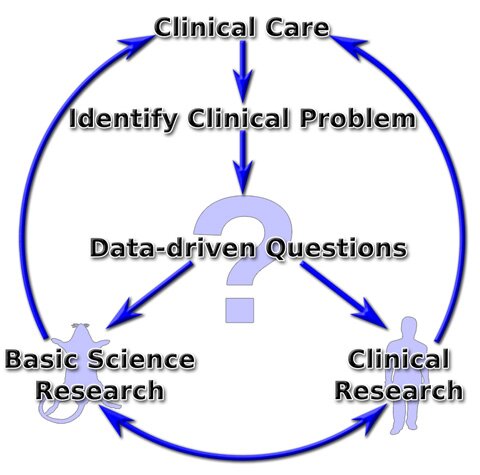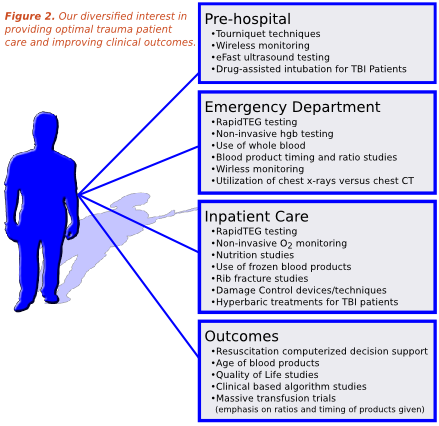Center Capabilities and Research Methodologies
Translating Science from the Bench to the Bedside
Jeanette Podbielski, RN; John B. Holcomb, MD; R. Michelle Sauer, PhD
OBJECTIVES/GOALS:
- Assist with the translation of ideas from the basic science level to clinical studies
- Assist with the translation between civilian and military populations
- Evalute and improve clinical practices
- Test/validate new medical interventions
- Implement new technologies to provide optimal trauma care and outcomes
METHODS:
Our approach to preparing research proposals is as follows:
- Identify a clinical problem
- Create data-driven questions
- Based on the questions, determine the best approach to providing the answer (utilizing basic science and clinical or both)
- Basic science research approach - helpful in evaluating the question through model systems that mimic the clinical problem
- Model systems are done on a cellular level as well as animal level
- Model systems look at PBBI, TBI, shock and hemorrhagic shock
- Mesenchymal Stem Cell research for TBI and hemostasis
- Clinical research approach - helpful in evaluating the question if it involves a large patient population
- Examples include prospective, observational studies from trauma patients upon arrival to the ED
- Questions to evaluate include: pre-hospital triage, blood transfusion practices, coagulopathy guidelines and utilization of clinical based algorithms.
- Basic Science and Clinical Research approaches can interact and assist each other to provide answers to the proposed question.
- Following completion of the studies, analysis is completed on data collected.
- The analysis is reviewed and decisions are made to
- Propose changes to clinical care based on results
- Pose additional questions leading to additional studies.
- Provide results from the civilian studies to the military for potential clinical use.
Figure 1. The research cycle.


AREAS OF INTEREST:
- Pre-hospital triage
- Earlier life saving interventions in the ED
- Administration of blood products
- Coagulopathy guidelines
- Utilization of clinical based algorithms
- Resuscitation computerized decision support
- Long-term outcomes
- Quality of life
RESULTS:
Currently, the clinical research team is participating in 20+ studies ranging from pre-hospital care to in-hospital resuscitation trials; interventional versus observational; and retrospective versus prospective.
Sponsorship is diversified among the state, the four military branches, industry, investigator initiated and NIH.
CONCLUSION:
Through collaborative efforts, our clinical team validates new devices and procedures to provide earlier treatment to the soldiers injured on the battlefield as well as test procedures and devices proven to be effective on the battlefield in the emergency setting of the civilian population. At the same time significant effort is put forth to observe and evaluate treatment protocols and patient populations to identify important patterns or trends.
Center Equipment
The CeTIR's laboratory spans over 3500 square feet, consistening of 14 contigous rooms in the Cetir-tmc.org Medical School building. CeTIR's lab is a comprehensive pre-clinical laboratory dedicated to pursing cutting-edge reserach in trauma. The laboratory is organized to allow for efficient workflow from cell and tissue culture to large and small animal surgeries. Core infrastruture within the laboratory includes hematology, tissue preparation and histology areas, microscopy, molecular biology, flow cytometry, molecular biology and forbe-probe cell or tissue manipulation. Major equipment avaliable in the laboratory includes;
- NOVA Stat Profile and i-Stat Analyzer—Used to analyze blood gas data
- Flow center & 2 Gallios flow cytometers—Flow cytometry machines are able to label and count biomarkers to sort cells and develop profiles
- Nexera SIL-30AC Autosampler and Nexera LC30-AD HPLC Pumps—Used to chromatographically separate samples and obtain spectral profiles from molecular mixtures
- SPD-20A UV Detector—Assesses samples by wavelength
- Multiple Thromboelastographs—Gives a clot ability profile on blood samples
- Beckman Epic Flow center—Flow cytometry machine
- UV Spectrophotometer—Assess samples by wavelength
- EMax Microplate Reader—Essential for assessing platelet profiles
- Thrombin Generation Assay—Analyzes thrombin levels and clot formation
- Centrifuges—Used to spin and seperate samples
- Luminometer—Assesses luminescence of samples
- Platelet aggregation profiler—Assesses platelet activity and clot ability
- ACL TOP Hemostasis System—Profiles blood samples
- Multiple Equipment Available for Small Animal Studies (PowerLab 4/30)



